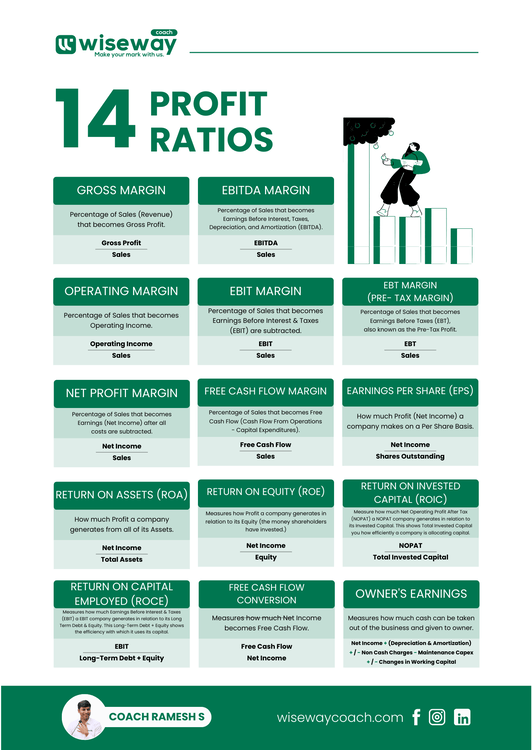14 Essential Profitability Ratios to Measure Business Success
July 4, 2024 2024-11-22 14:5414 Essential Profitability Ratios to Measure Business Success
14 Essential Profitability Ratios to Measure Business Success

Profitability ratios are key financial metrics that help evaluate a company’s ability to generate profit relative to its revenue, assets, equity, and capital. Here’s a breakdown of 14 profit ratios every business should know to assess financial health and performance:
1. Gross Margin
Formula
Gross Profit / Sales
Indicates the percentage of revenue that remains after covering the cost of goods sold (COGS).
2. EBITDA Margin
Formula
EBITDA / Sales
Shows the percentage of sales that translates into Earnings Before Interest, Taxes, Depreciation, and Amortization (EBITDA).
3. Operating Margin
Formula
Operating Income / Sales
Reflects the percentage of sales that becomes operating income after covering operating expenses.
4. EBIT Margin
Formula
EBIT / Sales
Measures the percentage of revenue that translates into Earnings Before Interest and Taxes (EBIT).
5. EBT Margin (Pre-Tax Margin)
Formula
EBT / Sales
Indicates the percentage of sales that turns into earnings before taxes, providing insight into pre-tax profitability.
6. Net Profit Margin
Formula
Net Income / Sales
Reveals the percentage of revenue that becomes net income after all expenses, taxes, and costs are deducted.
7. Free Cash Flow Margin
Formula
Free Cash Flow / Sales
Represents the percentage of sales that converts into free cash flow, considering cash flow from operations minus capital expenditures.
8. Earnings Per Share (EPS)
Formula
Net Income / Shares Outstanding
Shows the profit available per outstanding share, useful for investors assessing earnings.
9. Return on Assets (ROA)
Formula
Net Income / Equity
Measures how effectively a company uses its assets to generate profit.
10. Return on Equity (ROE)
Formula
Net Income / Equity
Indicates the profit generated relative to shareholders' equity, reflecting the company’s efficiency in generating returns.
11. Return on Invested Capital (ROIC)
Formula
NOPAT / Total Invested Capital
Assesses how effectively a company uses its invested capital to generate profit.
12. Return on Capital Employed (ROCE)
Formula
EBIT / (Long-Term Debt + Equity)
13. Free Cash Flow Conversion
Formula
Free Cash Flow / Net Income
Measures how much net income translates into free cash flow, indicating cash efficiency.
14. Owner’s Earnings
Formula
Net Income + (Depreciation & Amortization) - Non-Cash Charges - Maintenance Capex + Change in Working Capital
Highlights the cash available for business owners to withdraw or reinvest, providing insight into cash flow sustainability.

Why These Ratios Matter
Profitability ratios give a comprehensive view of a company’s financial health, operational efficiency, and ability to generate returns. By monitoring these metrics, businesses can make informed decisions to enhance growth and profitability.
Measuring profitability isn’t just about numbers; it’s about understanding what drives success and planning for sustainable growth.
– Coach Ramesh S

For More Details
Ready to elevate your business? Our tailored coaching programs help entrepreneurs unlock their potential and achieve sustainable growth. Start with a free strategy session to discover your roadmap to success!